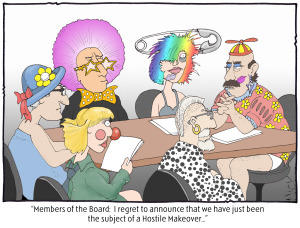Getting Fresh Blood on Your Board
Posted: October 27, 2014 Although I write in the season of ghoulish fun, there’s no holiday “spirit” lurking in this blog. By “fresh blood” I mean bringing on younger board members – not a token one or two, but developing a mindset and method for achieving greater age balance as a rule. I’ve talked often about board composition and urged organizations to think ahead on board demographics. This month I’m also inspired by a recent BoardSource conference I attended in Washington, D.C., which I’ll discuss in detail in my next dashboard.
Although I write in the season of ghoulish fun, there’s no holiday “spirit” lurking in this blog. By “fresh blood” I mean bringing on younger board members – not a token one or two, but developing a mindset and method for achieving greater age balance as a rule. I’ve talked often about board composition and urged organizations to think ahead on board demographics. This month I’m also inspired by a recent BoardSource conference I attended in Washington, D.C., which I’ll discuss in detail in my next dashboard.
I’m passionate about promoting young professionals for nonprofit boards because it’s vital. In fact, I’m chairing a panel on the topic in December. Those 20- and 30-something members are a nonprofit’s future. As donors, yes, but also as problem solvers and decision makers who can bring their generations’ particular sensibility to an organization.
Yet ask young professionals about board service and certain roadblocks arise. I did recently, and although some obstacles are personal, of course, I also found common factors that organizations can control. Addressing – at least considering – these is essential.
Communication and Culture
Communication – both what young professionals know and how they are addressed – is key to encouraging, or discouraging, thoughts of board service. Twenty- and 30-somethings are building careers and families. They have limited time but not necessarily limited interest. We know that engagement is what motivates individuals to take notice of an organization. To reach busy young adults, it’s even more critical to make a targeted effort to inform them about an organization’s vision, mission and significant accomplishments. Communicate examples that can spark enthusiasm for a nonprofit and reasons for young professionals to commit to greater involvement, ultimately as board members.
Organizations also need to assess their PR. At organizational events, is there a literal “old guard” that holds court? Are young professionals recruited for leadership roles, or does “experience” always trump other assets? The culture within an organization can be welcoming or intimidating to young potential board members. If change is needed, the place to start is with an honest picture of how young people are viewed – as core or peripheral – and how that perception is conveyed.
On the Board Training
Yes, I’m a broken record on board education – and here’s another reason to play the training tune one more time. Inviting novice younger members to learn while sitting on a board is an effective way to mentor them in board roles and responsibilities. Pairing veteran and junior members is increasingly recognized as valuable for orienting young board members, developing their own and fellow members’ confidence in their decision-making, and strengthening relationships on a board.
This approach tackles an oft-expressed concern I’ve heard among young professionals that they don’t feel knowledgeable enough about board governance to serve. In truth, I’ve advocated forever that every member regardless of age or experience should receive mandatory board education. That young board members are willing to admit what they don’t know – and follow a training path to competency – can be a boon to an entire board.
Looking to develop a more age-diverse board? Let’s talk.

